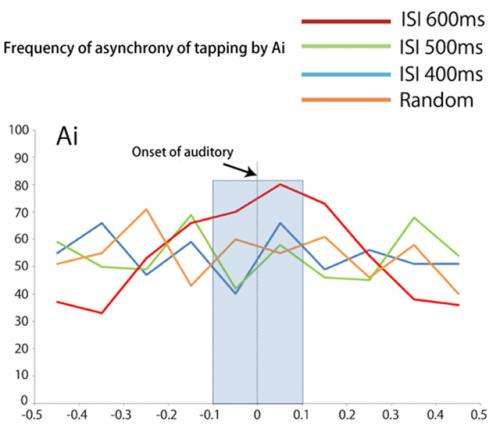Spontaneous synchronized tapping to an auditory rhythm observed in chimpanzee

A Kyoto University research team has revealed that a chimpanzee spontaneously synchronized her tapping to an auditory rhythm. The results are reported in Scientific Reports, a journal published by Nature group, on March 28, 2013.
Humans actively use behavioral synchrony such as dancing and singing when they intend to make affiliative relationships. Such advanced synchronous movement occurs even unconsciously when we hear rhythmically complex music. A foundation for this tendency may be an evolutionary adaptation for group living but evolutionary origins of human synchronous activity is unclear. Here the researchers show the first evidence that a member of our closest living relatives, a chimpanzee, spontaneously synchronizes her movement with an auditory rhythm. The result indicates that sensitivity to, and tendency toward synchronous movement with an auditory rhythm exist in chimpanzees, although humans may have expanded it to unique forms of auditory and visual communication during the course of human evolution.
Compared to other primate species, humans are known to have an advanced ability to synchronize their movements to external rhythms. In many cultures across the world behavioral synchrony occurs in activities such as marching, dancing and singing. From an early age, we can capture and interpret a beat in a rhythmic pattern; this allows us to sing and dance in time to music. However, little is known about evolutionary origins of such synchronous activity, so it is important to compare behavioral synchronization abilities and their effects on social relationship across primate species. Here the researchers experimentally investigated whether a member of our closest living relatives, chimpanzees have an ability to align their movement in synchronized auditory rhythms.
The researchers introduced an electric keyboard to three chimpanzees (Figure1) and trained them to tap two keys (i.e.,"C4" and "C5") alternately 30 times. Each key to be tapped was illuminated, and if a chimpanzee tapped this key (e.g., "C4"), sound feedback was given and another key was immediately illuminated (e.g.,"C5") so it was unlikely that the visual stimuli affected tapping rhythm by chimpanzees. When the chimpanzees tapped the two keys in alternation a total of 30 times, they received positive auditory feedback (a chime) and a reward. In a test session, a distractor sound (i.e., ISI 400ms, 500ms, 600ms, random with key of "G" or no sound) was played while the chimpanzees tapped the keyboard. The chimpanzees received rewards whenever they completed key tapping regardless of their responses to the distractor.

The results show that Ai spontaneously synchronized her tapping to the ISI-600ms auditory beat. Hearing the ISI-600ms sound beat, Ai spontaneously and accurately aligned her tapping to the beat even though she had never been required to pay attention to auditory stimuli. The analysis in No-stimulus and Random conditions suggests that her synchronized tapping cannot be explained away as random tapping or merely responding to sound. This is the first behavioral evidence that chimpanzees are sensitive to isochronous auditory stimuli and can synchronize their movements to these stimuli without explicit training. By comparing great apes, humans and other complex vocal learning species, the evolutionary origins of humans' widespread use of behavioral synchrony such as dance and music will be clarified.
More information: Hattori, Y., Tomonaga, M. and Matsuzawa, T. Spontaneous synchronized tapping to an auditory rhythm in a chimpanzee, Scientific Reports,3, 1556. doi:10.1038/srep01566
Journal information: Scientific Reports
Provided by Kyoto University




















